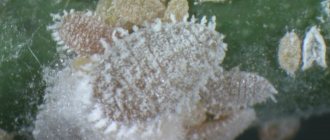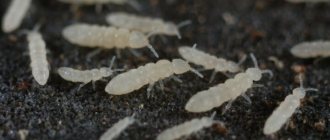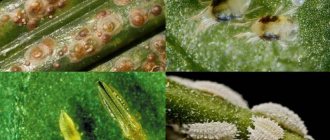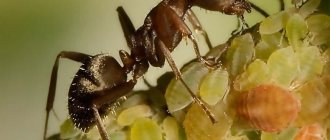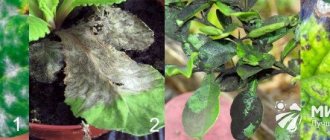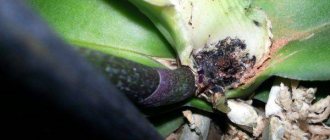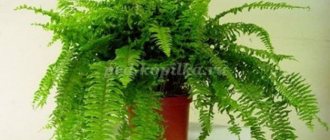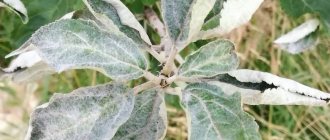Thrips on indoor plants are quite a common occurrence, further complicated by the fact that this insect is indiscriminate in terms of food. It successfully sucks juices from any species, without exception. This not only negatively affects the development of the flower, but can also lead to its death.
In addition, the pest multiplies quite quickly, which complicates its removal. It is important to know about measures to combat existing pests and how to protect indoor flowers from thrips invasion.
How to fight thrips on houseplants
Thrips on indoor plants: how to fight them in this protracted war? Agree, you don’t always win the battle with a pest. Thrips, unpleasant and dangerous insects, have many species that differ significantly from each other not only in size, but also in color. They attack the plant mainly with their numbers, because each individual reproduces every 6 days, doubling the colony. Therefore, the fight against them is difficult and lengthy. It seems that all the thrips have been destroyed, but after a couple of weeks they again draw all the juices out of the plant. The flower weakens and withers right before our eyes.
Mr. Summer resident informs: preventive measures
It is always easier to prevent any disease than to treat it. Therefore, you should listen to these simple tips:
- proper care should be provided to all indoor plants;
- should be watered regularly, not allowing the soil to dry out - thrips do not tolerate high humidity;
- for the same reason, it is necessary to regularly spray the flowers, creating a humid microclimate;
- When purchasing a new plant, be sure to carefully examine it for any types of diseases;
- try to install mosquito nets on windows, although they are not always able to protect against these pests.
What do thrips look like?
The most numerous insect pest species is thrips. Their size ranges from 0.5 mm to 5 mm. The color can also range from transparent milky individuals to black. The body is oblong, has two wings with a fringe characteristic of these insects located along the edge of the wing.
Indoor thrips species have a size of 1-1.5 mm. The appearance of insects can vary significantly even within the same species.
thrips varieties
The laid larvae are similar in appearance to the adults, but their color is usually translucent white or light yellow. They do not have wings, unlike adult insects. The most common and well-known types:
- Frankliniella intonsa is a multivorous thrips that damages the developing ovaries and flowers of the plant.
- Hercinothrips femoralis is an ornamental thrips that likes to settle on large plants such as amaryllis, chrysanthemums, callas, cacti and gardenias.
- Parthnothrips dracaenoe - dracaena thrips, spoils aralia, tradescantia, dracaena, hibiscus; Thrips fuscipennis - This thrips prefers forbs.
- Thrips tabaci - tobacco thrips; its name makes its preferences clear.
- Liothrips vaneeckei is an onion thrip that loves to eat gladioli bulbs.
Insects feed on the sap of the plants on which they settle. The paths that they gnaw in the tissues of leaves eventually become visible to the naked eye. In room conditions, the number of individuals doubles every 6 days.
Thrips pest - description
The length of the black, brown or gray body of thrips reaches from 0.5 to 3 mm, some species are much larger - about 14 mm. The legs of thrips are running, the mouthparts are asymmetrical, piercing-sucking, and the paws are without claws, but are equipped with teeth and a bubble-like suction device. The abdomen of thrips consists of 11 segments. There is fringe along the edges of the wings. Thrips develop through five stages: eggs, larvae, pronymphs, nymphs and adults. Thrips larvae have a grayish or white-yellow body, otherwise they differ from adults only in the absence of wings.
Thrips are polyphages, that is, omnivorous insects. They are one of the most common pests of agricultural, vegetable, fruit, ornamental and indoor crops. They pose a particular danger to plants indoors: if thrips are infested in greenhouses, it is very difficult to get rid of them; you can only contain their population numbers. It is difficult to detect these pests due to their small size and secretive lifestyle: they can parasitize one plant for a long time without spreading to neighboring ones.
Adults and larvae suck the sap from the above-ground parts of the plant and infect them with their secretions. First, discolored or yellowish spots, streaks or stripes appear at the bite sites, which gradually merge. As a result of the activity of pests, plant tissue dies, holes form in place of the spots, leaves wither and fall off, flowers lose their decorative effect and fall off prematurely. When a plant is massively occupied by thrips, silvery areas appear on its ground organs, the stems are bent, and the flowers are deformed due to the fact that the pests have damaged the flower buds. On top of that, thrips are carriers of incurable viral diseases.
- Methods for controlling aphids
Thrips on indoor flowers
Thrips love “thoroughbred” plants. Flowers such as:
- rose;
- dracaena;
- ficus;
- laurel;
- monstera;
- lemon;
- palm.
Although the insect can feed on any indoor plant. When infected with these harmful insects, the leaves of the plant begin to lighten. Numerous punctures appear from the thrips' voracious trunk.
plant leaf affected by thrips
At the same time, brown spots appear on the inside of the leaf. When insects attack a plant, they destroy the leaves and begin to die. Flower buds become deformed and inflorescences take on ugly shapes.
Criminal traces! If you carefully examine an indoor flower, you will see pollen spilling out from the stamens of the flowers on the leaves. This is a clear sign that a colony of thrips has settled on the plant. Although this can happen when the flower is shaken or infected by one of the types of mites.
To recognize the cause of pollen shedding and make sure that thrips are present or absent, pick a flower. Tap it lightly with a pencil or ballpoint pen on a dark-colored sheet of paper. This method will show whether the plant is infested with pests.
You can also experimentally determine what type of “beast” has settled on your pet. Perhaps a greenhouse or ornamental thrips has settled on the flower. Symptoms of thrips and flat mite infestations are very similar. But please note that thrips are harsher than ticks.
Over time, these pests will turn your gorgeous pet into an obvious ragamuffin with terrible “scars” on the leaves and barely alive flowers that are in the last stage of exhaustion. Petals speckled with dark and light spots, half-withered and deformed flowers evoke pity, not delight, when looking at them.
There are also types of thrips that have only one generation per year; these are usually local species brought into the home by the wind, or with flowers from the garden plot. Such species are peaceful in nature and will disappear from the “battlefield” by autumn.
You should be afraid of the appearance of California thrips on house flowers, a very harmful eater of indoor specimens.
How to recognize parasite damage
The thrips themselves are not always immediately detectable. They are quite secretive and prefer to manage individual plants, gradually moving to others.
Discoloration of some leaves should raise suspicion among the grower. Also, in flowering plants, pollen intensively spills from the stamens onto the petals (the same phenomenon can be observed during hot weather and as a result of a spider mite attack).
If, upon examination, many small punctures are recorded (like from a needle on fabric), it means that they were made by thrips, which means they drank juice from the plant.
Brownish or brown spots can be seen on the lower part of the leaf blades. These are damaged areas. When oxygen enters plant cells, they often take on a silver color. You can also notice a sticky mark and brown-black dots (thrips feces) on the leaf, which contribute to the development of a disease such as sooty fungus.
A late sign of a thrips attack (if rescue measures have not been taken) is the falling of leaves and flowers, as well as bending of the trunk.
Where do thrips come from?
Forewarned is forearmed! In the summer, flower pests easily penetrate into a person’s home with gusts of wind, with soil brought from the garden plot. When buying new varieties of house plants, you also run the risk of introducing pests into your home; there is no insurance against infection spread by thrips.
With onions brought from the dacha, California thrips gets into the house. Summer, a time of intensive exchange between gardeners with rare house plants, then? there is a danger of infection. At this time, flowers are often moved to balconies and loggias protected from the wind, but with drafts, when ventilated there is still a risk of catching thrips.
California thrips
Summer, heat and dry air are favorable conditions for the spread of this evil pest. He loves high summer temperatures. As the weather gets colder, the intensity of thrips distribution drops significantly.
What crops are most often affected by thrips?
Wheat thrips causes damage to cereals, corn and tobacco crops. Onion and tobacco thrips love garlic, onions, nightshade vegetables, umbrella vegetables and pumpkin. This universal species has no special preferences and attacks many vegetable, ornamental, fruit and berry crops.
The pink species is found on rosaceous plants. The buds and inflorescences of gladiolus are damaged by gladiolus thrips, and in the fall, if the pest is not exterminated, it settles at the base of the bulb and ends up in storage.
Western flower thrips (California thrips) are very dangerous and omnivorous. This is a quarantine parasite that is difficult to control. In large greenhouses, this species is capable of destroying all plants. It develops faster than other species, displacing them and producing up to 12-15 generations.
Among the indoor plants susceptible to thrips attack are ficus, palm trees, dracaenas, monstera, citrus fruits, saintpaulias, orchids, fuchsias, aspidistras, laurels, umbellas, cyclamens, gloxinias, pelargoniums.
Thrips control
Whatever plants become infected with thrips, preventive measures should be taken. Strictly monitor air humidity, pests cannot tolerate moisture. In the summer, give your green pets a shower, with soap foam, preferably from baby soap. This is an almost 100% guarantee against this malicious pest.
Be sure to conduct a visual inspection of your indoor garden once a week. You will admire your flowers and at the same time inspect them for infestation, both pests and any infection.
Stock up on adhesive tapes to place them among the leaves of plants; this is also a preventive measure in pest control. Everyone recommends using your own ribbon color; some say that thrips are best caught on pink, while others recommend blue.
Who claims that only the yellow color of the trap is suitable for catching pests? Thrips have wings, which means they can easily migrate from plant to plant. This is the reason for the rapid infection of green pets in the same room.
A fight for life and death! Thrips are persistent individuals and are extremely difficult to fight, mainly because they lay eggs inside the leaf. Since they are protected by fibers, they are practically indestructible; neither pesticides nor any other means take them.
thrips larva
Thrips love dry, hot air; at a temperature of +20-25˚C they double their numbers every 4-5 days. Just imagine what hordes of greedy and hungry pests these are. If you don't fight them, they will destroy everything that blooms and grows in the house.
If you find thrips on at least one plant, inspect the nearby flowers and give all your pets an urgent wash with soapy foam. This is prevention. Be sure to place the infected plant in quarantine, let it stand in a room separate from other seedlings, and you will observe it at this time.
The place where the infected pet stood? The top layer of soil in the pot should be removed and the substrate needs to be replaced. It should also be sprayed with insecticides. Before cultivating the soil, the plant should be given a shower; this will not harm it.
Note! Treatment with a soap solution is not a panacea; it is better to treat the plant with chemicals. Thrips are very difficult to destroy, so chemistry is better than the soap solution often used by gardeners.
Morphology and biology of the pest
Recognizing thrips is not that difficult. They look like small insects with an elongated body up to 2 mm long, light yellow, black or dark brown. Adults usually have two pairs of wings with long hairs.
The larvae of the pest have a light yellow body and do not exceed 1 mm in length. An additional clue about the presence of thrips can be the nature of their movement: adult individuals move very quickly, often making sharp jumps using their belly.
The difference between males and females is that the former have a slimmer, but not so long body. They are also painted in different colors.
Thrips can also be distinguished by their wings: in some species they can be quite short, in others they may not be at all. Thrips are one of many groups of pests that include more than 2,000 species. About 200 species live in our country.
Their main habitats are leaves, flowers and buds of indoor plants. They feed on nectar and sap from leaf tissue. Thrips are dangerous because they reproduce very quickly. Leaf tissue or flowers are used as a site for laying eggs.
After just 10 days, new offspring emerge from the eggs. However, it takes one month for the larvae to develop into adult insects.
At this moment, a great threat appears for plants, since as a result of the activity of pests they lose their attractiveness and begin to be affected by viral diseases. Over time, when insects drink all the juices from one plant, they move on to others located nearby.
So what are flower thrips? As we have already said, this is a small insect, usually one and a half millimeters long, but there are adults with a length of up to two and a half millimeters. Their wings are folded behind their backs; in a calm state, they form a light, narrow strip that is barely visible.
Adults are brownish, black or sandy in color, young ones are greenish, whitish, yellow. It is thanks to their camouflage coloring that these insects hide well and are difficult to detect.
The larvae do not have wings, they are small; quite a lot of effort must be made to detect and destroy them. Most insects hide among the stamens of the flower, in the axils of the leaves, so if you notice the first signs of damage, inspect your plant very carefully. The sooner you take action, the better for your pet.
When deciding how to deal with thrips on flowers, you must first become familiar with them and their biology in a little more detail. The biggest difficulty is their small size, several stages of development and virtually imperviousness to chemicals.
A single treatment of a plant can only slightly reduce the number of pests, but it will not be possible to completely remove them in one go.
Therefore, when fighting insects, it is recommended to divide the entire period into several parts, gradually destroying the pests. We also take into account that the eggs are not affected during processing, since they are located directly in the leaf tissue. Therefore, it is necessary to remove the affected leaves and carefully examine the remaining ones. Fighting thrips with pesticides may also not be successful, since they adapt well to any poisons.
At the larval stage, insects are generally inaccessible; they simply bury themselves in the ground near the root system, where there is no way to get them. Typically, two to three times the concentration of insecticides is required to cope with insects, which are incredibly resistant compared to other pests. The most stringent control measures are required here.
Common types of thrips
The first information about the existence of thrips was received back in 1744, when these pests were discovered by Karl de Geer. Today, people have become more aware of the species diversity of these pests, among which there are special species that infect ornamental plants more often than others:
The length of an adult insect is about 2 mm, the color can vary from light yellow to brown-yellow. California thrips prefer to live on buds and flowers, but the population can also reproduce on leaves.
California thrips are dangerous because they carry the tomato virus, which gives tomato leaves a bronze color. Western flower thrips is considered a very broadly polyphagous species.
It can feed on peppers, cucumbers, onions, tomatoes, grapes, peaches, strawberries and many other fruit and vegetable crops, as well as numerous ornamental and flower plants: gerberas, roses, daisies, chrysanthemums, Saintpaulias, cineraria, cyclamens.
Western flower thrips larvae and adults suck cell sap from plant tissue. This first causes the appearance of yellow spots on the buds, leaves or fruits, streaking; Gradually, plant tissues die in these affected areas.
Damage to flower buds in vegetable and fruit crops causes deformation of flowers and fruits.
For example, severe curling of flowers and curling of the fruits of a cucumber are a common sign that thrips has settled on the plant. When roses are infested with Western flower thrips, damaged buds do not open and dry out.
This pest lives in the middle zone and southern regions of our country. Here it is found on various ornamental plants grown in greenhouses and greenhouses. The insect itself is small, reaching a length of no more than 1 mm, and has a light yellow or brown color.
It is most widespread in the northern regions and central zone of our country. Poses a threat to many indoor plants.
Orchids, monstera, dieffenbachia and certain types of palm trees suffer the most from this pest. It can be identified by its dark brown color, as well as a small body that is 1.5-2 mm long.
Adult insects are about 1.3 mm long, females are yellow-brown in color, the male is slightly smaller and lighter. The larvae are white. This type of thrips is also a large polyphagous plant and is found on the leaves of a very large number of species of ornamental plants: orchids, monstera, aralia, tradescantia, anthurium, hibiscus, ficus, dracaena, palms and many others.
Under natural conditions, dracaena thrips is found in tropical and subtropical countries. In more northern latitudes it is widely distributed on plants in closed ground (in greenhouses, greenhouses).
In industrial greenhouse conditions, it is almost impossible to destroy thrips. At best, their numbers are kept to a level that would not affect the commercial quality of the products (flowers, fruits, vegetables).
This is due to the fact that thrips have a very high adaptation to pesticides. This is especially true for individuals that feed on flowers.
This species is represented in most of our country. The main food for it is flowers and buds of indoor plants. It looks like a dark brown insect, reaching a length of just over 1 mm.
Its favorite habitats are rosaceous plants. A characteristic feature is a brown body, reaching 1 mm in length.
This species is represented in most of our country. Most often it can be found among the scales of lily plants. It can be identified by its dark brown color and body up to 2 mm long.
The insect is dark brown or brown in color, from 1.3 mm (males) to 1.6 mm (females) in length. Echinothrips americana prefers to live mainly on leaves, in the tissue of which females lay their eggs. This type of thrips was discovered in the nineties of the last century in Holland at one of the popular flower auctions, to which plants are brought from all over the world.
Initially, thrips was discovered on orchids. Nowadays, American thrips are transported from country to country on cut flowers, seedlings, and ornamental potted plants.
American thrips activity is first visible by the appearance of yellow spots. The presence of ten thrips on one leaf is enough for it to begin to fade. 30-40 thrips individuals will lead to drying out and leaf fall, which begins from the lower tier. And although thrips do not directly lead to plant death, they significantly reduce the decorative value of flowers.
In search of food, thrips move to flowers and fruits or to neighboring plants and continue their life activities there. Due to the fact that the population of American thrips is spreading very quickly, there is a high probability of its spread not only on all floral and ornamental plants, but also on other vegetable crops grown in greenhouses.
Adult insects are about 1-1.5 mm long, dark brown or almost black in color with a brownish-brown abdomen and yellowish fore wings. The larvae are white or yellowish, differ from adults in being slightly smaller in size and lacking wings.
Adult insects and black thrips larvae usually live on the underside of leaves. The nature of plant damage is almost the same as that caused by tobacco thrips.
In closed ground (in greenhouses, greenhouses), black thrips is ubiquitous and reproduces all year round. Harm is caused by both adult insects and black thrips larvae, causing great damage to cucumbers, tomatoes, other vegetable and green crops, as well as potted and ornamental plants. Black thrips overwinters well in the top layer of soil under plant debris or in compost heaps.
What indoor plants do insects appear on?
These insects are omnivores and live on any plants. Their favorite indoor flowers are violets, ficus, lemons, begonias, roses, orchids and dracaenas. Thrips cause particular harm to violets, damaging the flowers.
The plant stops blooming and loses its decorative appearance.
The most favorable climate for insects is warm and dry air. They can appear in any home, but they actively reproduce most often in places where the plants are not sprayed or rarely watered.
How to detect and signs of flower infection
If, during the inspection of indoor plants, you find that some leaves have become discolored, and there are also many spots on them caused by punctures, then this is a clear sign that thrips have appeared in your apartment. If you pay attention to the lower part of the leaves, you can find brownish or brownish spots there.
Damaged areas often turn silvery, which can be explained by air entering the cells.
If prompt treatment measures are not taken at the first signs of thrips activity, the foliage will subsequently die and flowers and buds will become deformed. Insects cause additional harm by depositing sticky secretions, which provide a favorable environment for the development of sooty fungus.
Although thrips are not picky about their food, their most preferred indoor plants are violets, begonias, roses, citrus fruits, orchids and ficus. Violets suffer most from thrips larvae, as they destroy the anther of the flower.
At the first signs of their appearance, it is necessary to pick off all flowers and buds over the next 1.5 months, combining this with treatment with suitable preparations.
Unfortunately, the presence of insects is often discovered when the plant has already died. They hide in the axils of leaves and pistils of flowers. If you carefully examine the plant, you can find the following signs of thrips infestation:
- Small brown dots on the leaves are places from which insects drank juice;
- Many leaves darken, die, become discolored or become covered with gray stripes, and they may also be covered with lacy netting;
- Brown spots are visible on the underside of the leaf blade;
- Young leaves and shoots grow small and deformed;
- The flowers quickly dry out and fall off.
Almost all insects that parasitize indoor plants are sucking. Thrips are no exception; with their thin proboscis they penetrate the leaf of a plant and suck out the juice from it.
How to determine if a plant is infected:
Many consider this phenomenon to be a sunburn and try to remove the plant away from exposure to rays. However, this method will not bring results, since thrips larvae are to blame for this, destroying the leaves at great speed. Plus, accumulations of dirt appear on the flowers, which are insect excrement.
In addition, thrips carries various viral diseases that pose a great danger to plants, as they can die.
Parasites are characterized by the secretion of a liquid substance with a sticky consistency, which is an excellent breeding ground for sooty fungus. The most dangerous among the large number of varieties of thrips are tobacco, bulbous, herbivorous, ornamental, dracaena, rose and western flower. It is almost impossible to determine which of them affects the flowers in the apartment.
Danger to indoor plants
If you do not start fighting insects in time, they can completely destroy the plant. Thrips not only suck the juice from the leaves, causing them to die. They are carriers of dangerous flower diseases, such as fungus. By multiplying quickly, insects spoil the decorative appearance of the flower and, over time, completely destroy it.
The plant fades, the leaves darken, lose their shape, and the flowers fall off. The danger of these pests is that it is very difficult to notice them; they hide in the axils of leaves or between the stamens of a flower. The larvae generally bury themselves in the ground, so many plant treatment methods do not work on them.
Discovery of thrips on indoor plants usually occurs after the flower begins to look depressed.
The most dangerous are considered to be decorative, Californian, tobacco, and greenhouse thrips, which are capable of transmitting various viral infections between flowers. The first sign of damage is pollen, which spills from the stamens onto the petals.
But you should be careful, since this phenomenon can also occur when the weather is too hot, when affected by certain types of ticks. It’s quite easy to check; we pick a few flowers and shake them over black paper, after which we inspect the leaf.
The degree of damage may vary, depending on the type of pest. For example, Californian thrips, as well as ornamental and tobacco thrips, are provoked not only on leaves, but also on flowers; the lesions are very similar to those caused by spider mites, leafhoppers, and flat beetles.
Flowers wither, quickly become deformed, and become covered with specks of black and white.
The surface of the leaves is similar to fabric that has been pierced many times with a needle. There is an abundance of pollen on the lower leaves. Thrips pests can enter an apartment through open windows, along with bouquets that were brought from open ground, with infected plants. Garden flowers are also susceptible to attack by pests; even unpretentious gladioli (propagation by seeds, children) and the well-known bearded irises can suffer from their harmful activities.
Remedies for thrips
In war, all means are good! Products used for spraying plants often require additional actions, such as covering the flower with a plastic bag for a day. So, get to know these drugs:
- Vertimek - dilute 2.5 ml of the drug in 200 ml of water, spray the infected flower with this solution and cover with a bag.
- Fitoverm - dissolve 2 ml of the drug in 200 ml of water, and spray the plant, covering it with a transparent bag for a day.
- Aktelik - dilute 1 ampoule in 1 liter of water, the solution has a very pungent odor, it is better to process it in the fresh air. Spray the plant and cover with a bag.
- Agravertine - take 5 ml of the drug for half a liter and dilute it in warm water not lower than +18˚C; at low temperatures it does not saturate plant tissues well. Treat the flower with the prepared solution and again cover it with a bag for a day.
- Confidor - the soil of an infected flower is treated with a solution.
- Kabofos is a proven remedy for pest control; it is also used on the plant substrate.
- Intavir - dilute 1 tablet per 10 liters of water, spray the plant with it, cover with a plastic bag.
After 24 hours, remove the covering bags from plants treated with one of the listed preparations. Spraying should be done every ten days of the month until the pests are completely destroyed.
Harm to plants
The main harm of thrips lies in their inconspicuousness - the first generation of pests settles on weeds, and not on cultivated plants. Since these insects have wings, adult individuals move to industrial, grain, fruit, ornamental and vegetable plantings. Thrips are responsible for the loss of large amounts of crops.
On a note. If 12 thrips larvae settle on one bush of a cultivated plant, the yield loss will be above 50%.
Often these pests attack buds, and sometimes even completely destroy plantings of flowers that are suitable for cutting. These small insects extract vital juices from flowers, leaves and ovaries of plants. Thus, they disrupt the nutritional processes of the crop and become responsible for the withering of their generative and vegetative parts.
Thrips are also carriers of pathogens of various viral diseases.
How to recognize damage to a crop by thrips:
- When a first instar larva settles on a plant, different parts of the crop immediately become covered with silver-gray spots. As the parasite gains strength, these marks become larger, merge and cause parts of the plant to die.
- If the larva chooses buds as a place to live, they become sticky and may not open.
- If thrips has affected the fruits and ovaries, they look asymmetrical and twisted.
How to deal with pests at home
On the forums they talk about how to combat flower pests at home:
- Collage advises: spray the plant with condifor, and writes that he is amazed at the result. After treating the flower with the solution, by evening the thrips fell off dead and he never saw them on the plant again. The solution was prepared in the following proportion: 1 gram of the drug per half-liter jar of water.
- Kroki: got rid of thrips using the drug phytovert. A one-time treatment was enough, but to calm your conscience, you can do one more. Some time after the destruction of the “conquerors”, the plant should be supported with epin.
- Natali advises: if signs of a plant becoming infected with thrips appear, cut off all flower ovaries. They are still deformed; pests will “help” them with this. It's difficult to fight them. The plant must be treated several times, possibly several times when the larvae emerge into the “light.” Therefore, about 5 treatments are carried out to destroy the entire thrips colony. You cannot leave even one pest alive.
In the greenhouse
You can fight thrips in greenhouses with the help of biological preparations, for example, Thripol-L. To increase its effectiveness, it will be necessary to increase daylight hours to 14 hours. If this is not possible, then introducing a predatory bug (or other entomophages) into greenhouse structures is more effective only from April to September.
Using glue or pheromone traps will help reduce the number of adults. It is important to know that the latter option is effective in catching males. Their use must be combined with the simultaneous placement of glue traps.
How to destroy a pest
Strategic offensive plan! In the initial stage of flower infection, it is possible to fight the pest by spraying it with infusion of tobacco, hot pepper, and soap solution. But these are weak “medicines” against thrips; they can rather be called preventive than curative.
This pest is persistent and it is very difficult to get rid of it with weak infusions. Better use insecticides. In the fight against thrips, natural remedies recede; only chemistry can cope.
At what temperature do thrips die?
The optimal temperature for the development and life of thrips ranges from +15 to +30˚С. At the egg stage, too high a temperature is not required, since it tends to dry out and then die, +20-25 degrees, the best conditions for eggs.
Then comes the time of the larvae, at +27˚C it begins to molt. Five days is enough for her to reach the size of an adult; after molting, she turns into a protonymph.
thrips nymph
High temperature +27˚С promotes rapid (within 24 hours) transformation into a nymph. After three days she is already an imago, and a day later the mature thrips will make its first flight.
An individual lives for a month or a month and a half, the lowest temperature of the pest’s existence is +9.5˚C. Below the temperature is not acceptable for this aggressor; at zero or below the thermometer mark, death awaits him. It overwinters in the soil in the adult stage.
Prevention is easier than control
The difficult fight against thrips makes everyone regret the untimely measures taken. They are often “introduced” onto house plants with purchased summer plants, seedlings and new flowers, even if they only come into the house for a few hours. Quarantine measures, the absence of “contact” of seedlings with house plants and the allocation of several weeks for adaptation and isolation of newcomers are the most important steps in order to prevent the spread of the ubiquitous thrips.
There are other measures that will help, if not prevent the appearance of thrips, then reduce the harm from them to a minimum:
- purchasing substrate from trusted manufacturers (thrips are introduced into soil only slightly less frequently than with plants);
- protecting plants from extremely dry air and maintaining optimal performance for individual species;
- regular warm showers (for all plants for which it is acceptable);
- using glue traps that attract aphids, thrips and other insects and allow them to be quickly identified.
But no measures can replace attentiveness - regular inspection of bushes, especially the back side of leaves and shoots. Traces noticed in time will allow action to be taken in the early stages, preventing the spread of thrips throughout the collection. After all, the sooner the struggle begins, the greater the chances of success.
What to do with the land?
To prevent thrips colonies from settling on indoor flowers, the air in the room must contain a certain percentage of humidity. Plants should be watered and the soil in the pots should always be slightly damp.
If infected after treatment with insecticides, the soil should be changed to a depth of five centimeters; this guarantees that there are no thrips larvae left in the soil. Since it is difficult to fight them, it is better to follow preventive methods.
Fight against "spies"! For “vagrant” pests, it is worth placing sticky traps in blue, pink, and yellow on flowers. Thrips on indoor flowers are, of course, a big nuisance, but you learned how to deal with them.
Life cycle
The pest goes through several stages until it becomes an adult: egg, larva, pronymph, nymph, adult.
The female lays up to 100 eggs. The higher the temperature, the faster the eggs are laid. At a temperature of 15-16°C they hatch after 15-20 days, at 28-30°C - after 1-2 weeks. In temperate climates in open ground, one generation often develops per season; in greenhouse conditions, a pest colony can double in a week.
The larval stage of thrips lasts 1-2 weeks, during which the pest feeds by sucking plant juices. After pupation, a pronymph with wing rudiments emerges from the larva for 1-3 days. At the next stage, the nymph, which lasts 2-3 weeks, the insect already has poorly developed wings, but without tassels and cannot yet fly. When thrips become adults, they become active, jumping, flying and feeding.
The average lifespan of an adult thrips is 30-40 days, with females being 2-2.5 times longer than males. The pest breeds indoors all year round, but overwinters outdoors as larvae in plant debris. This insect can survive winters with little snow and frosts down to -40°C.
Basic care mistakes
Anthurium can hardly be called a capricious plant, but mistakes in cultivation can be disastrous for it. Here are the main signs that you can use to understand that something is wrong with your plant.
Table: main anthurium diseases and their causes
| Signs | Causes | |||
| Diseases | Pests | Nutritional imbalances | Other reasons | |
| Leaves turn yellow | — | Spider mites, aphids | Chlorine in irrigation water |
|
| The leaves turn black | — | — | Too much calcium in the soil |
|
| Brown spots on leaves | Septoria, rust | Aphid | — |
|
| Black spots on leaves, brown tubercles | — | Shchitovka | — | — |
| Brown spots with a yellow rim | Septoria | — | — | — |
| The plant is drying up | Anthracnose | — | — | Lack of moisture in the soil or air |
| Dark spots on leaves | — | Thrips | — |
|
| Purple-brown spots on leaves | Late blight | — | — | — |
| Yellow, faded leaves | — | — | Lack of nutrients in the soil |
|
| Pimples on leaves | — | — | Excessive watering | |
| Cobwebs on leaves | — | Spider mite | — | — |
| The leaves are turning pale | — | — | Lack of nutrients in the soil |
|
| White chlorotic spots on leaves | Downy mildew | — | — | — |
| Small flowers/leaves | — | — | Lack of microelements in the soil | Insufficient watering |
| Massive yellowing, leaf dieback, or root rotting | Fusarium wilt | — | — | Prolonged excess moisture |
| The leaves are curling | — | Aphid | — |
|
| The leaves are fading | Septoria | Scale insect, thrips | — | — |
| Leaves “cry” after watering | — | — | — | A combination of abundant watering and moist air (guttation) |
| White coating on leaves | Powdery mildew | — | — | — |
| Pinkish coating on the root collar | Fusarium wilt | — | — | — |
| Deformed leaves | — | Trips | — | — |
| Torn leaves | — | — | — | Dry air |
| Sticky leaves | — | Shchitovka | — | — |
| Flowers turn green | — | — | Lack of nutrients in the soil | — |
| The flowers are drying up | — | — | Insufficient nutrients in the soil | Dry air |
| Pimples on peduncles | — | Shchitovka | — | — |
| Doesn't grow | — | — | Lack of nutrients in the soil |
|
| The plant is withering | — | Aphids, scale insects, thrips | Nutritional deficiencies | Insufficient watering |
| The flower does not take root | — | Aphids, scale insects, thrips | Lack of nutrients in the soil | — |
| Anthurium trunk rotted | Fusarium wilt | — | — | Excessive watering |
| The growing point has rotted | Fusarium wilt | — | — | Excessive watering |
| Anthurium dries up | — | — | — |
|
| Anthurium does not bloom | — | — | — |
|
| The leg of the anthurium turns black | — | — | — | Excessive watering |
| The plant is falling apart | Mycoses | — | — | Excessive watering |
| Slowly growing | Damage by pests, diseases | Lack of nutrients in the soil | Lack of lighting | |
Errors in anthurium care are usually easy to correct (replace the plant from the battery, water more or less, feed, change the windowsill, etc.), but dealing with dangerous diseases and pests is not so easy.
Fungal and bacterial infection of anthurium roots
But anthurium has an extremely negative attitude towards excessive watering, and in this case, especially with dense soil, the gardener observes not only yellowing and drying foliage. One of the most serious problems for anthurium lovers is the development of root rot, which is facilitated by excess soil moisture and lack of oxygen in the soil.
Anthurium root rot can be controlled using a wide range of fungicides.
But this measure is not enough. Because it doesn't solve the main problem. If the grower suspects that the anthurium is drying out and turning yellow due to putrefactive processes, the plant must be removed from the pot for inspection and treatment.
After cleaning the anthurium roots from soil residues, the blackened, destroyed areas are cut off and treated with crushed coal, and, if necessary, with fungicides. The plant is transplanted into new disinfected soil, and the pot itself must be steamed or treated with a solution of potassium permanganate.
Anthurium is difficult to tolerate infectious and fungal diseases. Therefore, it is much easier and more effective to take care of prevention by establishing proper watering and selecting a loose soil mixture for the plant.
Features of soil and watering for the health of anthurium
Actively flowering anthurium species require regular fertilization during the growing season, which should support both the formation of new buds and the general condition of the anthurium. When choosing a product for feeding, it is better to give preference to formulations with a limited amount of nitrogen, which activates the formation of foliage, and a high content of phosphorus, which is responsible for the quality of flowering.
If the anthurium turns yellow or dries out, it may be due to excess nutrients in the soil. In this case, mineral salts that are not absorbed by the roots of the anthurium provoke a burn of the underground parts of the plants, as well as the active reproduction of pathogenic microflora.
When there is a suspicion that the anthurium is drying out due to an excess of fertilizers, it is necessary to rinse the earthen ball, or transplant the pet into a new substrate.
Transplantation is required when the root system of the plant has completely penetrated the substrate and no longer has free space. It is better to carry out this procedure in early spring, transferring the plants to a new, larger pot. But do not forget that anthuriums have a fairly effective tool for obtaining nutrition from the atmosphere. These are aerial roots of anthurium that cannot be removed, but it is more useful to use their susceptibility to both foliar feeding and spraying the crown with clean moisture.
